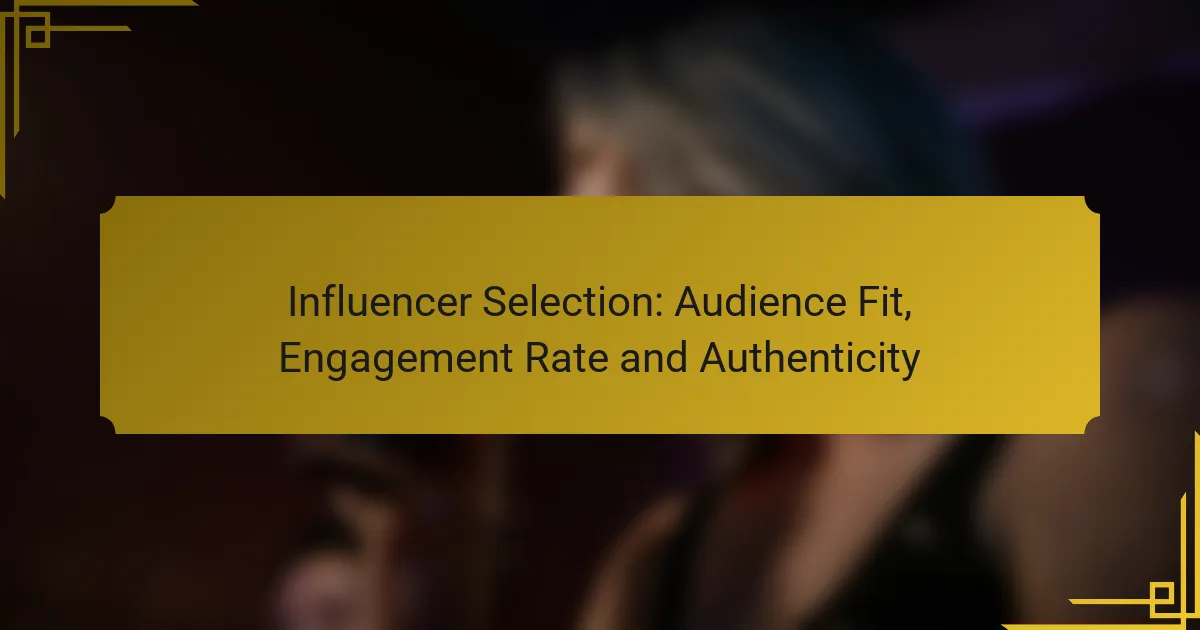Choosing the right influencer for your brand requires careful consideration of audience fit, engagement rate, and authenticity. Ensuring that an influencer’s followers align with your target market can significantly enhance your marketing effectiveness. Additionally, a high engagement rate indicates a responsive audience, while authenticity fosters trust and loyalty, leading to more successful campaigns.

How to select influencers based on audience fit?
Selecting influencers based on audience fit involves ensuring their followers align with your target market. This alignment enhances the effectiveness of your marketing efforts and fosters genuine connections with potential customers.
Demographic alignment
Demographic alignment refers to matching the influencer’s audience characteristics with your brand’s target demographics. Key factors include age, gender, location, and income level. For instance, if your product is aimed at young adults, an influencer whose audience primarily consists of individuals aged 18-24 would be a suitable choice.
To assess demographic alignment, use analytics tools that provide insights into an influencer’s audience. Look for influencers whose followers reflect the same demographic profile as your ideal customers to maximize engagement and conversion rates.
Psychographic matching
Psychographic matching focuses on the values, interests, and lifestyles of both the influencer’s audience and your target market. Understanding these aspects helps ensure that the influencer’s content resonates with potential customers. For example, if your brand promotes eco-friendly products, collaborating with influencers who advocate for sustainability can enhance authenticity.
To evaluate psychographic compatibility, analyze the influencer’s content themes and engagement patterns. Look for shared values and interests that align with your brand’s messaging to create a cohesive partnership.
Brand values compatibility
Brand values compatibility is crucial for maintaining authenticity in influencer partnerships. It involves ensuring that the influencer’s personal brand aligns with your company’s mission and values. For example, if your brand emphasizes inclusivity, partnering with influencers who actively promote diversity can strengthen your brand’s image.
To assess compatibility, review the influencer’s previous collaborations and content. Ensure their messaging aligns with your brand’s core values to foster trust and credibility among your audience.

What is the importance of engagement rate in influencer selection?
Engagement rate is a critical metric in influencer selection as it reflects how actively an audience interacts with an influencer’s content. A higher engagement rate typically indicates a more invested and responsive audience, which can lead to better campaign outcomes.
High engagement indicates active audience
A high engagement rate signifies that the audience is not just passively consuming content but actively participating through likes, comments, and shares. This interaction often correlates with trust and loyalty, making it more likely that followers will respond positively to promotional messages.
For brands, selecting influencers with high engagement rates can result in more effective marketing strategies. An influencer with a dedicated and engaged audience can drive higher conversion rates, as their followers are more likely to act on recommendations.
Engagement rate benchmarks by platform
Engagement rates can vary significantly across different social media platforms. For instance, Instagram typically sees higher engagement rates compared to Facebook, with averages often ranging from 1% to 5% for most accounts. TikTok can exhibit even higher rates, sometimes exceeding 10% for popular creators.
When evaluating influencers, consider the platform’s norms and your target audience. For example, a micro-influencer on Instagram may have a smaller following but a much higher engagement rate, making them a valuable asset for niche marketing campaigns.

How to assess influencer authenticity?
To assess influencer authenticity, focus on their engagement with followers, content quality, and genuine interactions. Authentic influencers typically have a loyal audience that trusts their opinions and recommendations.
Analyzing follower growth patterns
Examine the growth patterns of an influencer’s followers over time. A steady increase in followers, particularly during organic campaigns, indicates authenticity, while sudden spikes may suggest the use of bots or purchased followers.
Look for consistency in follower growth. Influencers who gain followers at a moderate pace are more likely to have a genuine audience. Tools like social media analytics can help track these trends effectively.
Evaluating content quality and consistency
Assess the quality of an influencer’s content by looking for originality, relevance, and alignment with their audience’s interests. High-quality visuals, thoughtful captions, and engaging storytelling are signs of an authentic influencer.
Consistency in posting is also crucial. Authentic influencers maintain a regular posting schedule and stay true to their niche. A sudden shift in content style or frequency may indicate a lack of authenticity or a focus on trends over genuine engagement.

What tools can help in influencer selection?
Several tools can assist in influencer selection by providing insights into audience fit, engagement rates, and authenticity. Utilizing these platforms can streamline the process of identifying the right influencers for your brand.
Upfluence for audience insights
Upfluence offers comprehensive audience insights that help brands understand the demographics and interests of an influencer’s followers. This tool allows you to filter influencers based on specific criteria, such as age, location, and interests, ensuring a better match with your target audience.
When using Upfluence, consider analyzing engagement metrics alongside audience demographics. A high follower count may not equate to effective reach if the audience does not align with your brand values. Aim for influencers whose audience engagement rates fall within the 1-5% range for optimal results.
HypeAuditor for authenticity checks
HypeAuditor specializes in verifying the authenticity of an influencer’s audience, helping brands avoid fraud and ensuring genuine engagement. This tool provides metrics on follower quality, engagement rates, and potential fake followers, allowing for informed decision-making.
To effectively use HypeAuditor, focus on the authenticity score provided for each influencer. A score above 80% generally indicates a trustworthy influencer. Regularly check for sudden spikes in follower counts, which may signal artificial growth tactics. This vigilance can save brands from costly partnerships with influencers lacking genuine connections.

What are the criteria for effective influencer partnerships?
Effective influencer partnerships hinge on three main criteria: clear campaign objectives, mutual audience understanding, and the influencer’s authenticity. These elements ensure that collaborations resonate with the target audience and drive meaningful engagement.
Clear campaign objectives
Establishing clear campaign objectives is essential for any influencer partnership. These goals should outline what the brand aims to achieve, whether it’s increasing brand awareness, driving sales, or promoting a specific product. Defining these objectives helps in selecting the right influencer who aligns with the campaign’s vision.
Consider using the SMART criteria—Specific, Measurable, Achievable, Relevant, Time-bound—to formulate your objectives. For instance, a goal could be to increase website traffic by 20% within three months through influencer promotions. This clarity allows for better tracking and evaluation of the partnership’s success.
Mutual audience understanding
Understanding the mutual audience is crucial for effective influencer partnerships. Both the brand and the influencer should have a clear grasp of their target demographics, interests, and behaviors. This alignment ensures that the content resonates with the audience, enhancing engagement and conversion rates.
Research tools like audience analytics and social media insights can provide valuable data about followers. For example, if a beauty brand partners with a skincare influencer, they should ensure that the influencer’s audience primarily consists of individuals interested in skincare products. This shared audience connection fosters authenticity and trust, leading to more successful campaigns.

How to measure the success of influencer collaborations?
Measuring the success of influencer collaborations involves assessing engagement metrics and analyzing conversion rates. These metrics provide insights into how well the partnership resonates with the target audience and its effectiveness in driving desired actions.
Tracking engagement metrics
Engagement metrics are crucial for evaluating the effectiveness of influencer collaborations. Key metrics include likes, shares, comments, and overall reach. A high engagement rate typically indicates that the audience finds the content relatable and appealing.
To calculate engagement rate, divide the total engagement (likes, comments, shares) by the total number of followers, then multiply by 100. For example, if an influencer has 10,000 followers and receives 500 engagements, the engagement rate would be 5%. Aim for engagement rates above 2% for effective partnerships.
Analyzing conversion rates
Conversion rates measure how well an influencer collaboration drives specific actions, such as purchases or sign-ups. This metric is essential for determining the return on investment (ROI) of the campaign. A higher conversion rate indicates that the influencer’s audience is responding positively to the call to action.
To analyze conversion rates, track the number of conversions generated from the influencer’s content and divide it by the total number of clicks or impressions. For instance, if an influencer’s post generates 200 clicks and results in 20 purchases, the conversion rate is 10%. Focus on optimizing the content and call to action to improve these rates.

What are the emerging trends in influencer marketing?
Emerging trends in influencer marketing highlight a shift towards authenticity, audience alignment, and engagement metrics. Brands are increasingly prioritizing meaningful connections over sheer follower counts, focusing on influencers who resonate with their target demographics.
Rise of micro-influencers
Micro-influencers, typically defined as individuals with 1,000 to 100,000 followers, are gaining traction due to their perceived authenticity and higher engagement rates. Brands find that these influencers often foster stronger relationships with their audiences, resulting in more impactful campaigns.
When selecting micro-influencers, consider their niche relevance and engagement metrics. A micro-influencer in a specific industry can yield better results than a celebrity with millions of followers but little connection to the brand’s message.
Increased focus on long-term partnerships
Brands are increasingly shifting from one-off collaborations to long-term partnerships with influencers. This approach allows for deeper storytelling and brand loyalty, as influencers can authentically integrate products into their content over time.
To establish effective long-term relationships, brands should prioritize transparency and mutual benefit. Clear communication regarding expectations and deliverables can help avoid common pitfalls, such as misalignment in brand messaging or influencer fatigue.

How to adapt influencer strategies for different platforms?
Adapting influencer strategies for different platforms involves understanding the unique characteristics and audience preferences of each platform. Tailoring content and engagement tactics can significantly enhance the effectiveness of influencer partnerships.
Content format variations by platform
Each social media platform has its preferred content formats that resonate best with users. For instance, Instagram thrives on high-quality images and short videos, while TikTok focuses on engaging short-form videos that often incorporate trends and challenges.
On platforms like Twitter, concise text updates and threads work well, while YouTube favors longer, in-depth video content. Brands should consider these variations when selecting influencers, ensuring their content aligns with platform norms to maximize reach and engagement.
Additionally, understanding the audience demographics on each platform can guide content creation. For example, younger audiences may prefer TikTok and Instagram, while older demographics might engage more on Facebook or LinkedIn. Tailoring content to fit these preferences is crucial for successful influencer campaigns.
